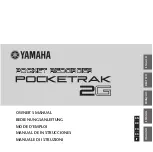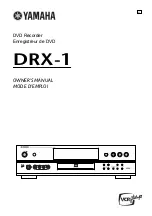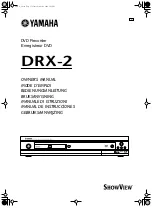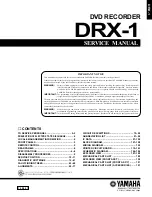
Circuit-, IC descriptions and list of abbreviations
9.
9.
Circuit-, IC descriptions and list of abbreviations
9.1
Display Board
9.1.1
Microcontroller
The core element of the Display Control unit is the
microcontroller TMP87CH74AF [7110]. The TMP87CH74AF is
an 8 bit microcontroller fitted with 32kB ROM and 1kB RAM. It
requires 5V supply and is responsible for the following
functions:
–
Interface to Central Controller-P
–
Evaluation of the keyboard matrix
–
Decoding the remote control commands from the infra-red
receiver
–
Activation and control of the local display
–
Heater voltage generation
The 8 MHz resonator (Pos. 1111) generates the system clock.
The reset is generated by the CC-P via “POR_DC”-signal
where the transistor [7106] is used as a level-shifter from 3V3
to 5V.
9.1.2
Interface to the Central Control
µ
P
The communication to the main microcontroller (CC) on the P-
Sub-PCB is done via I2C-Interface, where the TMP87CH74AF
acts in slave-mode.
An additional wire (“INT”-line) is used to signal the Central
controller that data are ready, e.g. when a key has been
pressed.
9.1.3
Evaluation of the keyboard matrix
There are 12 different keys on the display board. A resistor
network is used to generate a specific direct voltage value,
depending on the pressed key. Via the resistors 3107 and 3102
on the analog/digital (A/D) ports (7103 pin 37 and 38) the
evaluation is done.
9.1.4
IR receiver and signal evaluation
The IR receiver [7107] contains a selectively controlled
amplifier as well as a photo-diode. The photo-diode changes
the received infra red transmission (approx. 940nm) to
electrical pulses, which are then amplified and demodulated.
On the output of the IR receiver [7107], a pulse sequence with
TTL-level, which corresponds to the envelope curve of the
received IR remote control command, can be measured. This
pulse sequence is fed into the controller for further processing
via port TC1 [7103, pin20].
9.1.5
Vacuum Fluorescence Display
The VFD “BJ900GNK” [POS 7100] is fully controlled by the
microcontroller. The
µ
C also includes the driving stages. Only
two additional drivers [POS 7101 and 7102] are necessary for
the grids 8 and 9 because of their large size.
9.1.6
VFD Heater Voltage Generator
The circuit around POS [7106, 7108 and 7109] is used to
generate a proper AC-Voltage for the filament of the VFD. For
this the microcontroller generates an appropriate rectangular
signal with 50% duty-cycle and a frequency of 30 kHz at pin 19.
Pos. [5104] and [2113] are acting as a resonance-circuit. Via
Zener-Diode (POS[6100]) and resistors [3119, 3122 and 3123]
the two heater-pins of the VFD (“FIL1” and “FIL2”) are clamped
so that the grids and segments can be fully switched off.
9.1.7
REC-LED
The REC-LED-ring is made with 3 red LED, controlled via pin
3 (only for flashing) and pin 12 for on/off switching, of the
microcontroller. The POS [7105] is used as a driver for the led.
9.1.8
EPG-LED
The EPG led is a white led and controlled from the pin 14 from
the microcontroller. The POS [7110] is used as a driver for the
led.
9.1.9
TRAY-LED
There are 6 leds (chip) necessary to illuminate the tray, these
6 leds are located on a little sub-pcb connected over a 4 pin
connector POS [1911] from the DC-print. The leds are
controlled from pin 11 of the microcontroller.
9.2
Microcontroller Sub Board (UP SUB Board)
9.2.1
General
This small PCB is directly soldered in on top of the Analogue-
Board.
It is used with no diversity in all three different basic versions
(Europe, NAFTA and APAC-Pal). Only the software being
loaded into the external Flash-memory is not the same.
9.2.2
Microcontroller
The main part of the Sub-PCB is the central controller (CC)
µ
P
[7804] TMP91CW12AF, which is a 16-bit CPU with 128kBROM
and 4kB RAM.
It works with a 3V3 supply and a system clock of 24,576MHz
[1801].
The 3V3-supply is made out of the “5VSTBY” by the circuit
around [7816].
After connecting the set to the mains (power-up) the IC [7806]
generates a reset pulse. This signal (“IPOR”) is directly fed to
first priority interrupt input (pin 63) for power fail detection and
also to the Reset-Input of the CC (Pin30) via [7802], which is
necessary to generate a reset only during power-up. In case of
power fail pin 30 of the CC must be kept high (3V3).
The internal memory of the CC is too small for all necessary
demands. Therefore an external Flash-ROM [7805] with
1MByte in size and a RAM [7803] with 128kByte are
necessary. Both parts are connected to the
µ
P via a parallel
address-/data-bus. The lower eight bus-lines (AD0 to AD7) are
multiplexed by [7801] and the “ALE”-signal of the CC.
For updating of the software the external Flash-ROM can be
reprogrammed by the
µ
P. During this process [7807] is
switched on by the “WE”-signal.
When no mains is connected, the CC is supplied via Gold-Cap
[2816] during the power backup period. The diode [6802]
prevents unwanted current consumption of other components.
The internal ROM of the
µ
P holds the program code for the
Real-Time-Clock. Only the microprocessor is supplied by the
backup cell, not the external memories and the
µ
P operates in
a low frequency mode with the clock crystal [1805] only (32.768
kHz). To adjust the clock the frequency can be measured at pin
87 of the
µ
P in a special test-mode.
9.2.3
Control-Interfaces
The CC is communicating with the digital board via a serial
connection, which operates at a speed of 19,4 kbit/s
(“D_DATA”-, “A_DATA”, “D_RDY”- and “A_RDY”-signal on
Summary of Contents for DVDR70/001
Page 88: ...Diagnostic Software EN 88 DVDR70 DVDR75 0x1 5 ...
Page 138: ...EN 138 DVDR70 DVDR75 0x1 7 Circuit Diagrams and PWB Layouts Layout DVIO Board Part 1 Top View ...
Page 139: ...Circuit Diagrams and PWB Layouts EN 139 DVDR70 DVDR75 0x1 7 Layout DVIO Board Part 2 Top View ...
Page 166: ...EN 166 DVDR70 DVDR75 0x1 7 Circuit Diagrams and PWB Layouts ...
Page 194: ...Circuit IC descriptions and list of abbreviations EN 194 DVDR70 DVDR75 0x1 9 Figure 9 15 ...
Page 195: ...Circuit IC descriptions and list of abbreviations EN 195 DVDR70 DVDR75 0x1 9 Figure 9 16 ...
Page 220: ...Circuit IC descriptions and list of abbreviations EN 220 DVDR70 DVDR75 0x1 9 ...
Page 221: ...Circuit IC descriptions and list of abbreviations EN 221 DVDR70 DVDR75 0x1 9 ...
Page 223: ...Circuit IC descriptions and list of abbreviations EN 223 DVDR70 DVDR75 0x1 9 ...
Page 224: ...Circuit IC descriptions and list of abbreviations EN 224 DVDR70 DVDR75 0x1 9 ...
Page 225: ...Circuit IC descriptions and list of abbreviations EN 225 DVDR70 DVDR75 0x1 9 ...
Page 226: ...Circuit IC descriptions and list of abbreviations EN 226 DVDR70 DVDR75 0x1 9 ...
Page 227: ...Circuit IC descriptions and list of abbreviations EN 227 DVDR70 DVDR75 0x1 9 ...
Page 228: ...Circuit IC descriptions and list of abbreviations EN 228 DVDR70 DVDR75 0x1 9 ...
Page 229: ...Circuit IC descriptions and list of abbreviations EN 229 DVDR70 DVDR75 0x1 9 ...
Page 231: ...Circuit IC descriptions and list of abbreviations EN 231 DVDR70 DVDR75 0x1 9 ...
Page 232: ...Circuit IC descriptions and list of abbreviations EN 232 DVDR70 DVDR75 0x1 9 ...
Page 233: ...Circuit IC descriptions and list of abbreviations EN 233 DVDR70 DVDR75 0x1 9 ...
Page 235: ...Circuit IC descriptions and list of abbreviations EN 235 DVDR70 DVDR75 0x1 9 ...
Page 237: ...Circuit IC descriptions and list of abbreviations EN 237 DVDR70 DVDR75 0x1 9 ...
Page 238: ...Circuit IC descriptions and list of abbreviations EN 238 DVDR70 DVDR75 0x1 9 ...
















































